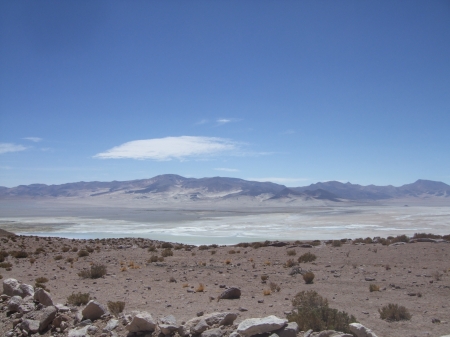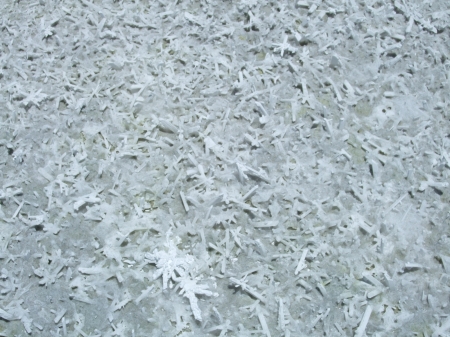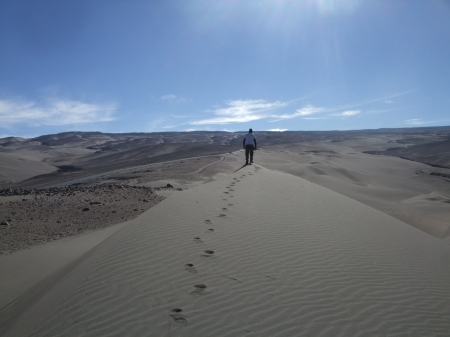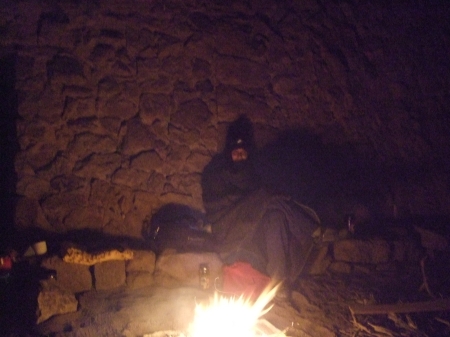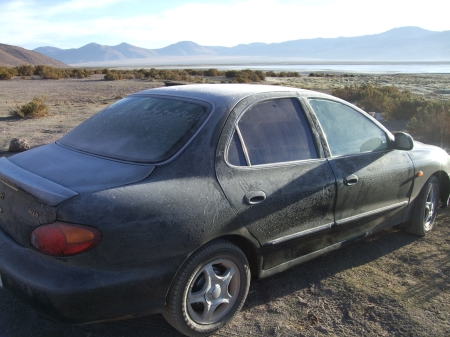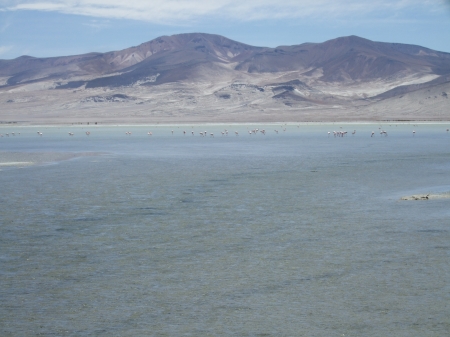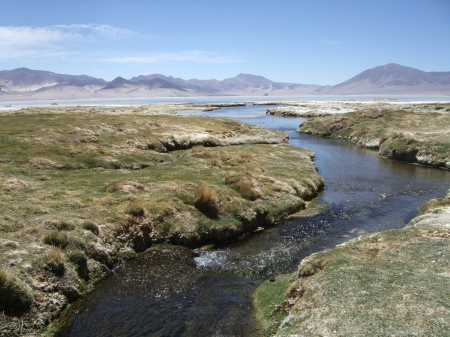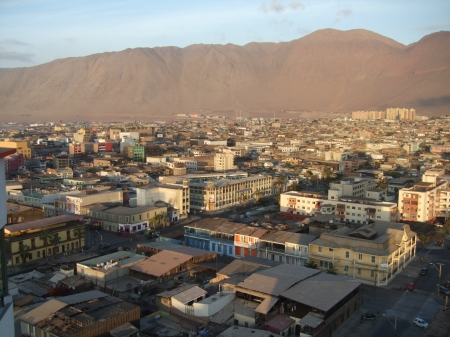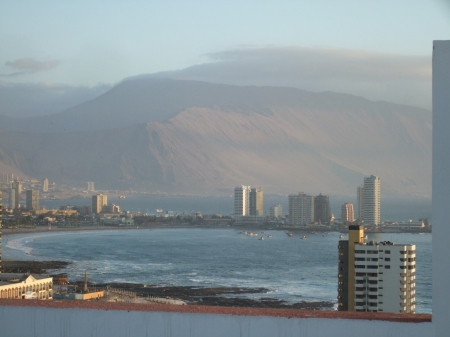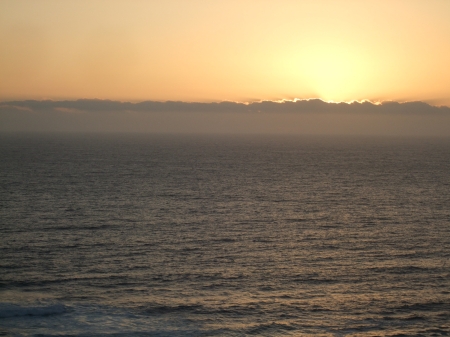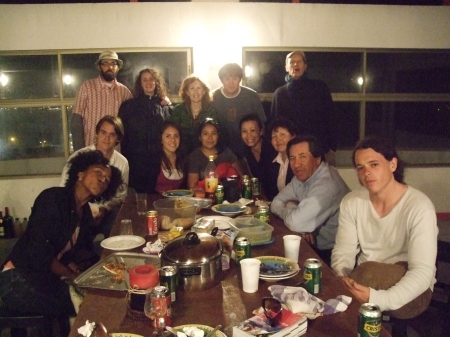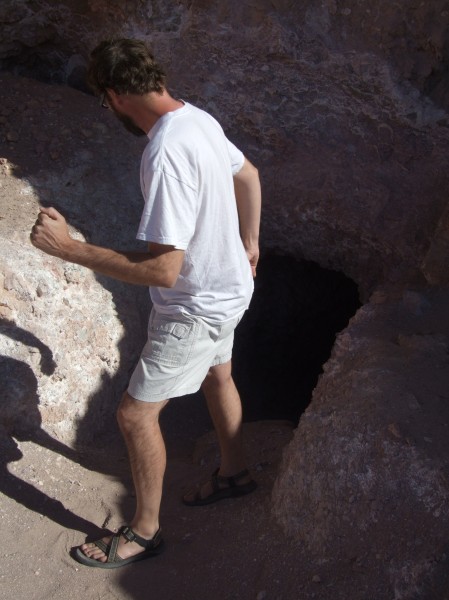
Running from history
Travel Dates: October 30-31, 2009
After a farewell swim and Frisbee session at Playa Seis, we jumped back in our rental car and climbed the switchbacks out of Pisagua into the open desert. Once we hooked back up with the Pan-American, we headed south. Our first stop was at a War of the Pacific battlefield, The Battle of Dolores. The memorial sits 3 km west of the Pan-American among groves of tamarugo and adobe ruins, commemorating the November 19, 1879 Chilean victory over Peru/Bolivia in the Tarapaca campaign.

Gigante de Tarapaca
Our next stop was the biggest archaeological representation of a human in the world, El Gigante de Tarapaca (Atacama). The 86 meter tall El Gigante reclines on the west slope of Cerro Unita, a small hill in the middle of flat sprawling desert, 14 km off the Pan-American east of the town of Huara. Archaeologists believe the geoglyph dates from around 900 A.D and think it represents a powerful shaman, a mysterious monument baking in the sun and overlooking the sprawling Atacama below. Quoting the Lonely Planet: “Its skinny limbs are spread wide, and it clutches what seems to be an arrowhead in one hand and a medicine bag in the other. Its open mouth and owl-like head, topped by vertical rays (and horizontal lines only visible from above), give it the perpetual appearance of hair-raising shock.” The details of the Giant are most clearly seen from above. Begging the question: Who was flying around spying it from above in 900 A.D? One of many unanswered mysteries. Without access to a flying machine, we contented ourselves with the view of the Giant from below.
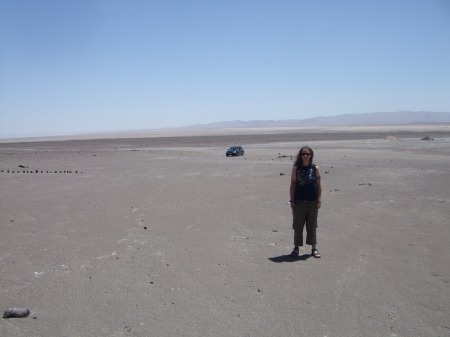
Em, our car, and the Atacama below El Gigante
The Atacama is filled with geoglyphs, most of their meanings are mysterious. There is a huge cluster of geoglyphs at Pintados, 45 kilometers south of Pozo Almonte. The geoglyphs of Pintados are within the Reserva Nacional Pampa del Tamarugal and administered by CONAF (Corporacion Nacional Forestal ). After communing with El Gigante, we returned to the Pan-American and headed south towards Pintados. We stopped in Pozo Almonte to pick up some supplies on the way. At Pintados, 355 geoglyphs line the desert hills that sit overlooking a long, wide salt flat, Salar de Pintados. The geoglyphs include geometrical designs, human depictions, and animal depictions. To quote the Lonely Planet once again: “These enigmatic geoglyphs are thought to have served as signposts to nomadic peoples: marking the trade routes and meeting points, indicating the presence of water, identifying ethnic groups and expressing religious meaning. Most date from between AD 500 and AD 1450.” We spent two hours roaming the site and taking in all the intricate geoglyphs on the hills, pondering how, who, and why they were built.

Geoglyphs de Pintados
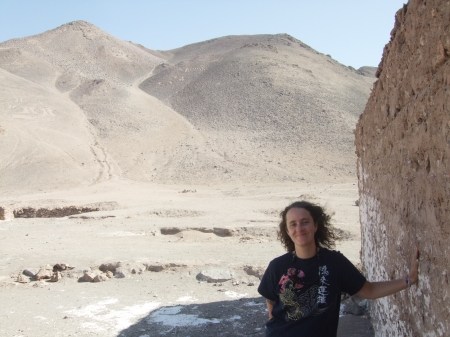
Em and adobe wall at Pintados
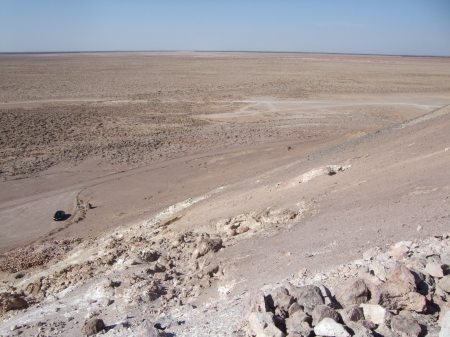
Looking down on Salar de Pintado
After Pintados, we headed east to the town of Pica for a nighttime swim under a big moon at Cocha Resbaladero. Following our swim, we headed back to the west, out of the green oasis of Pica and across bleak Atacama flats to hook back up with the Pan-American. We headed north on the Pan-American for 20 kilometers until we reached the roadside CONAF campground in Reserva Nacional Pampa del Tamarugal. The campground was deserted and we had it all to ourselves. It looked like it had recently been undergoing improvements to spruce it up. The sites were nice and big and cordoned off from each other in little compounds enclosed by combination stone walls and wood fences. Most of the sites included a nice tamarugo tree with a picnic table nestled underneath. We chose an end site and settled in, enjoying the rest of the night star and moon gazing amidst the tamarugos.
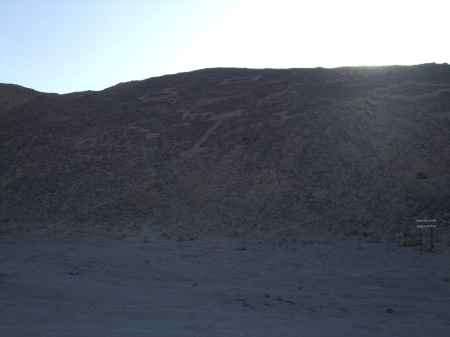
Mas geoglifos de Pintados
We were up early the next morning and on the road back to Iquique. We had to return the rental car at noon. We rolled back into Iquique at 9:30 am. With plenty of time to spare, we decided to visit Monumento al Marinero Desconcido (Monument to the Unknown Sailor) that sits along the coast to the north of town. It commemorates the May 21, 1879 War of the Pacific Battle of Iquique between Chile and Peru. The legendary Chilean ship, Esmeralda, captained by national hero Arturo Prat, which had plagued the Peruvian navy during the war with numerous heroics and naval victories, was finally sunk by the Peruvian monitor Huascar. After a prolonged battle, at 12:10pm, the Huascar finally scored the death blow. The iron clad behemoth rammed the wooden Esmeralda broadside and sent it to the bottom of the ocean. Captain Arturo Pratt famously rallied his troops to fight to the death and lept onto the deck of the Huascar wielding his sword. He fell dead on the deck of the Huascar and moved into the history books as one of Chile’s most treasured military heroes. His name spreads across Iquique: Avenue Arturo Prat, Plaza Prat, Universidad de Arturo Prat, etc….. and across Chile. His face graces the 10,000 peso note, and May 21 is a national holiday to commemorate Arturo and his men and their heroics in Iquique. The Esmeralda still sits on the ocean floor in the bay offshore of the monument. Its resting place is marked by a patriotic red, white, and blue buoy in the sea. A couple months ago, we took a harbor tour on a boat that took us out and around the buoy marking the heroic event. An upcoming movie focusing on the heroics of Arturo Prat and his final day was recently shot in Iquique. It included a re-creation of the battle with scaled replicas. The replica Esmeralda, like the real one, was sent to the bottom of the ocean, rammed by the replica 1/3 scale Huascar, which still sits anchored in Iquique’s harbor. There are plans in the works to build an Esmeralda replica for Iquique’s harbor. The real Huascar, captured by the Chileans later in the war, now sits in the harbor of Chile’s main naval base in Talcahuano in central Chile as a museum ship.
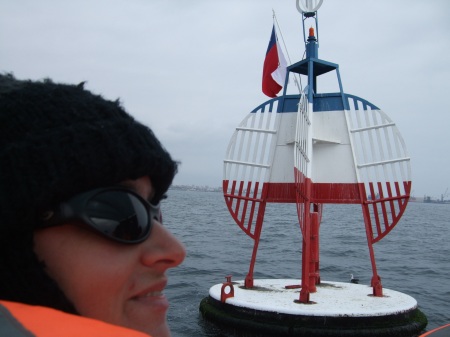
Em and Esmeralda buoy
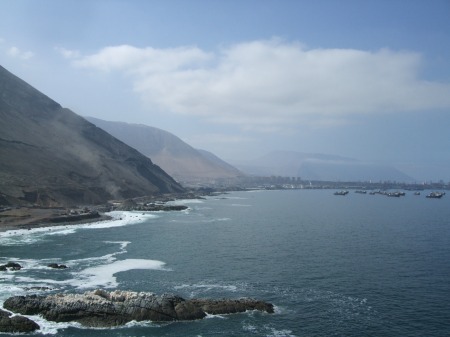
Fruits of victory: looking south towards Iquique
May 21, 1879 was not a total loss for the Chileans. The battle was two pronged: Esmeralda vs. Huascar, with the Huascar emerging victorious; and the Chilean fishing boat Covadonga versus the Peruvian frigate Independencia. The Covadonga emerged victorious in that battle. After a prolonged running battle, the Covadonga sunk the Independencia south of Iquique at Punta Gruesa, salvaging some of the day for the Chilean side against all odds. We sat on the cliff top memorial overlooking the sea contemplating naval heroics of the past and the denizens of Davy Jones Locker. Then, we made our way back through town to drop our stuff off at home before returning the rental car after a great 72 hours plying the roads and history of Tarapaca.
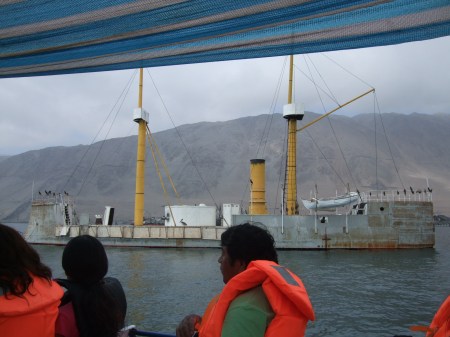
Huascar 1/3 scale replica
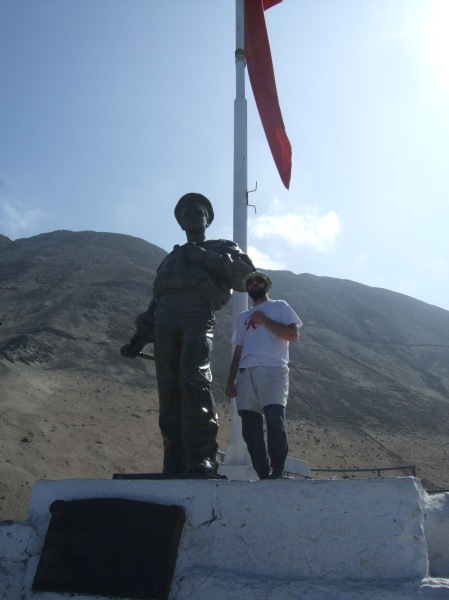
Monumento al Marino Desconcido

